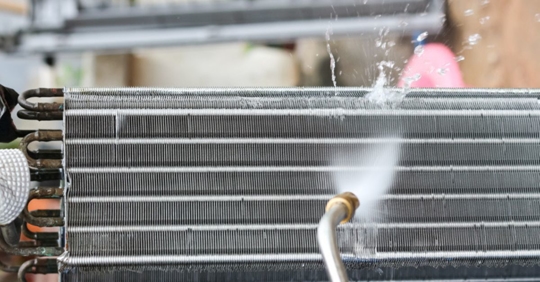Types of AC Systems
Before diving into maintenance, it's crucial to understand the type of air conditioning system you have. Central air conditioning systems are popular in many homes, providing consistent cooling throughout the entire house via a network of ducts. These systems require regular maintenance of both the indoor and outdoor units to ensure optimal performance. In contrast, ductless mini-split systems offer flexibility by allowing you to control the temperature in individual rooms. These units are ideal for homes without ductwork and are relatively easy to maintain, though they still require periodic cleaning and inspection. Lastly, window units are a cost-effective solution for cooling single rooms. While they are simpler to install and maintain, they still need regular cleaning and filter changes to function efficiently. Understanding the unique maintenance needs of each system type can help you prepare your AC for the summer heat.
Key Components of an AC System
To keep your air conditioning system running smoothly, it's essential to know its key components and their functions. The compressor is the heart of the system, responsible for circulating refrigerant between the indoor and outdoor units. It compresses the refrigerant, turning it into a high-pressure gas that releases heat as it travels through the condenser coils. The evaporator coil, located inside your home, absorbs heat from the air, cooling it before it's circulated back into your living space. The condenser, typically found in the outdoor unit, releases the absorbed heat outside. Each of these components plays a vital role in cooling your home, and regular maintenance can prevent issues like refrigerant leaks or coil damage. By understanding these components, you can better identify potential problems and ensure your AC system is ready for summer.
Signs Your AC Needs Maintenance
Recognizing the signs that your air conditioning system needs maintenance can save you from costly repairs and uncomfortable summer days. Unusual noises, such as grinding or squealing, often indicate a mechanical issue that requires immediate attention. Reduced airflow might suggest a clogged filter or a problem with the blower fan, both of which can hinder your system's efficiency. Inconsistent cooling, where some rooms are cooler than others, may be a sign of ductwork issues or a failing thermostat. Additionally, if you notice an increase in your energy bills without a corresponding increase in usage, your AC system might be working harder than necessary due to underlying problems. By addressing these signs promptly, you can ensure your AC system operates efficiently throughout the summer months.
Visual Inspection of Equipment
Before the summer heat arrives, a thorough visual inspection of your AC system can help identify potential issues. Start by examining the outdoor unit for any visible signs of wear and tear, such as rust, corrosion, or physical damage to the casing. Check for leaks or pooling water around the unit, which could indicate a refrigerant leak or drainage issue. Inspect the fan blades for any signs of damage or debris that could obstruct their movement. Inside your home, look for any visible damage to the ductwork, such as holes or disconnected sections, which can lead to air leaks and reduced efficiency. By conducting a visual inspection, you can catch small problems before they escalate into major repairs, ensuring your AC system is ready for the summer season.
Testing Thermostat Functionality
Your thermostat plays a crucial role in maintaining a comfortable indoor temperature, so it's essential to ensure it's functioning correctly. Start by setting your thermostat to a few degrees lower than the current room temperature and listen for the AC system to kick on. If there's a delay or the system doesn't start, there may be an issue with the thermostat's wiring or settings. Check the thermostat's display for any error messages or low battery warnings, which could affect its performance. If you have a programmable or smart thermostat, verify that the cooling schedules are set correctly for the upcoming summer months. Ensuring your thermostat is in good working order can help maintain consistent cooling and prevent unnecessary energy consumption.
Checking Electrical Connections
Inspecting the electrical connections of your AC system is a critical step in ensuring safety and efficiency. Begin by turning off the power to your AC unit at the breaker box to prevent any electrical hazards. Carefully examine the wiring for any signs of fraying, corrosion, or loose connections, which could lead to electrical shorts or system malfunctions. Pay special attention to the connections at the compressor and condenser, as these components are vital to your system's operation. If you notice any issues or are unsure about the condition of the wiring, it's best to contact a professional technician. Regularly checking and maintaining the electrical connections can prevent potential hazards and keep your AC system running smoothly throughout the summer.
Changing or Cleaning Air Filters
One of the simplest yet most effective maintenance tasks for your AC system is changing or cleaning the air filters. Dirty filters can restrict airflow, reducing your system's efficiency and potentially leading to higher energy bills. Depending on the type of filter your system uses, you may need to replace it every 1-3 months or clean it if it's reusable. To change the filter, locate the filter compartment, usually near the return air duct or the air handler, and remove the old filter. Insert the new filter, ensuring it's facing the correct direction as indicated by the arrows on the frame. Regularly changing or cleaning your air filters can improve indoor air quality and help your AC system operate more efficiently.
Cleaning Condenser and Evaporator Coils
Over time, dirt and debris can accumulate on the condenser and evaporator coils, hindering your AC system's performance. To clean the condenser coils, start by turning off the power to the unit and removing any debris from around the outdoor unit. Use a soft brush or a vacuum with a brush attachment to gently remove dirt from the coils. For more thorough cleaning, you can use a coil cleaner spray, following the manufacturer's instructions. To clean the evaporator coils, you'll need to access the indoor unit, which may require removing a panel. Use a soft brush to remove dust and dirt, and consider using a no-rinse coil cleaner for deeper cleaning. Keeping the coils clean can improve your system's efficiency and prevent potential issues.
Clearing Debris from Outdoor Unit
Ensuring proper airflow around your outdoor unit is crucial for efficient operation. Begin by clearing any leaves, dirt, or debris that have accumulated around the unit. Trim back any vegetation or branches that may obstruct airflow, maintaining at least two feet of clearance on all sides. Check the unit's base for any signs of settling or tilting, which could affect its performance. If necessary, level the unit by adjusting the base or using shims. Regularly clearing debris from around the outdoor unit can prevent airflow restrictions and help your AC system run more efficiently during the summer months.
Benefits of Professional Tune-Ups
While regular DIY maintenance is essential, scheduling a professional AC tune-up offers several advantages. A professional technician has the expertise to identify and address potential issues that may not be apparent during a visual inspection. They can perform a comprehensive check of your system, including testing refrigerant levels, inspecting electrical connections, and cleaning components like the blower motor and fan blades. A professional tune-up can improve your system's efficiency, extend its lifespan, and prevent costly repairs down the line. By investing in professional maintenance, you can ensure your AC system is ready to handle the summer heat and keep your home comfortable.
What to Expect During a Professional Inspection
During a professional AC maintenance visit, the technician will perform a series of checks and adjustments to ensure your system is operating at peak efficiency. They will start by inspecting the thermostat and testing its functionality, followed by checking the refrigerant levels and looking for any leaks. The technician will also examine the electrical connections and components for signs of wear or damage. Additionally, they will clean the condenser and evaporator coils, as well as the blower motor and fan blades, to ensure optimal airflow. Finally, the technician will test the system's overall performance and make any necessary adjustments to improve efficiency. By understanding what to expect during a professional inspection, you can be confident that your AC system is in good hands.
Finding a Qualified HVAC Technician
Choosing the right HVAC technician is crucial for ensuring quality maintenance and repairs. Start by researching local HVAC companies and checking their certifications, such as NATE (North American Technician Excellence) or EPA (Environmental Protection Agency) certification. Read customer reviews and testimonials to gauge the company's reputation and level of service. Ask for recommendations from friends or family who have had positive experiences with local technicians. When contacting potential technicians, inquire about their experience with your specific type of AC system and request a detailed estimate for the services they provide. By taking the time to find a qualified HVAC technician, you can ensure your AC system receives the best possible care.
Programmable Thermostats and Smart Controls
Upgrading to a programmable or smart thermostat can significantly enhance your AC system's efficiency and reduce energy costs. Programmable thermostats allow you to set cooling schedules that align with your daily routine, ensuring your system only runs when needed. Smart thermostats take it a step further by learning your preferences and adjusting settings automatically for optimal comfort and efficiency. Many smart thermostats also offer remote control via smartphone apps, allowing you to adjust settings from anywhere. By investing in a programmable or smart thermostat, you can optimize your cooling schedule, reduce energy consumption, and save on utility bills.
Sealing and Insulating Your Home
Proper insulation and sealing are essential for maintaining a comfortable indoor temperature and reducing the load on your AC system. Start by inspecting your home for any gaps or cracks around windows, doors, and other openings, and seal them with weatherstripping or caulk. Check your attic and walls for adequate insulation, and consider adding more if necessary to prevent heat transfer. Insulating your ductwork can also help prevent cool air from escaping and improve your system's efficiency. By sealing and insulating your home, you can keep cool air inside, reduce energy consumption, and lower your utility bills.
Utilizing Fans and Ventilation
Using fans and natural ventilation can complement your AC system and help maintain comfort while saving energy. Ceiling fans can circulate cool air throughout your home, allowing you to set your thermostat a few degrees higher without sacrificing comfort. In the evenings, when outdoor temperatures drop, consider opening windows to let in the cool breeze and ventilate your home naturally. Exhaust fans in kitchens and bathrooms can also help remove heat and humidity, reducing the strain on your AC system. By utilizing fans and ventilation, you can enhance your home's comfort and reduce energy costs.
(978) 733-9593 Is Here for You This Summer
As the summer heat approaches, ensuring your AC system is in top condition is essential for maintaining a comfortable home. At Village Home Services, we specialize in comprehensive AC installation and repair services. Our team of qualified HVAC technicians is dedicated to providing top-notch service and ensuring your system operates efficiently throughout the season. Whether you need a professional tune-up, repairs, or assistance with energy-saving upgrades, we're here to help. Contact Village Home Services today to schedule an appointment and experience the peace of mind that comes with a well-maintained AC system.
Call Village Home Services now at (978) 733-9593 or send us a message online.

